LX-5029 Accelerated Acid Etch Part II
Technical Bulletins
Posted 2023
Last Updated 2023
LX-5029
Abstract
For decades, automotive coatings have experienced degradation in the form of etching on coatings exposed to acid rain. As a result, procedures were developed to simulate and accelerate this type of degradation. These procedures failed to accurately simulate the etch produced in the product’s service environment because they lacked the critical field components necessary to reproduce this type of degradation.
In 2002, BASF and Q-Lab Corporation (formerly Q-Panel Lab Products) developed a new procedure to reproduce acid etch in the laboratory. This procedure, known as the BASF Accelerated Acid Etch Test (BAAT), was the first of its kind to provide excellent correlation with the coatings’ actual service performance. This unprecedented level of correlation was achieved by incorporating all the critical stresses including humidity, UV, moisture, appropriate acid solution and horizontal specimen orienta - tion into the exposure cycle. Since its inception, the BAAT procedure has been used as a screening tool for automotive clearcoats.
There has been ongoing research to improve and substantiate correlation with field results, and to optimize the test procedure. First, temperature settings from the original BAAT have been adjusted to improve practicality. Next, new evaluation techniques using modern instrumentation were performed to further quantify exposure results. Finally, additional outdoor exposures determined the following: results do not differ significantly between sites on Blount Island, coated panels can be used interchangeably for actual automotive hoods and a horizontal orientation provides the best etch results. Cumulatively, this research provides the automotive industry with a practical, viable test method to replace Jacksonville exposure testing, without sacrificing correlation.
Background History
Description of Acid Etch. In the 1980s, damage to auto - motive coatings from acid rain events became a problem. Both dealerships and buyers complained about the ring type or “water spot” etches that were formed on the coat - ing. These etches are caused when water from acid rain evaporates and the remaining acid concentration produces acid hydrolysis reactions with the clearcoat. This causes cracking and loss of paint that takes the shape of a water spot.
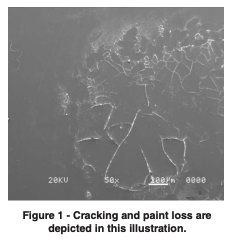
Blount Island Exposure. Because Blount Island in Jacksonville, Florida is one of the most severe locations in North America for the conditions that cause acid etch, it is the benchmark exposure site for annual field tests to assess acid etch resistance of automotive coatings. Numerous hoods, panels and fascia are tested in Jacksonville each year by Automotive OEMs and their suppliers. The typical testing period is from June to September of each year and test specimens are rated for etch damage at varying times throughout this period. This has been done by using a method of visual evaluation with standard panels used as a guide.
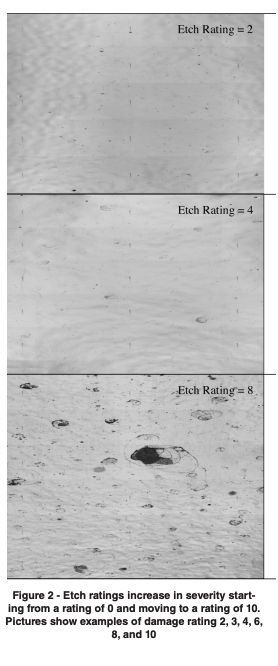
While the Blount Island exposures have the benefit of real-world testing, there are significant limitations to the procedure in terms of product development. Limitations include the inconvenience of a single location, the narrow time frame for testing, and the variability of the results from year to year. Recognizing these limitations, BASF and Q-Lab Corporation joined forces to develop a test method that allows for accelerated, realistic and repeatable acid etch results.
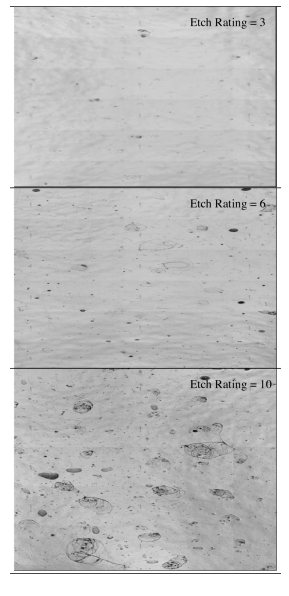
BASF Accelerated Acid Test (BAAT) Development
Before this joint BASF/Q-Lab test method was developed, many attempts had been made at developing laboratory techniques to predict etch resistance of automotive clearcoats (e.g. Gradient Bar Test, the Acid Spot Test, etc.). None of these tests included all of the environmental factors that contribute to the etching of automotive clearcoats (humidity, UV light, specimen orientation, acidic solution).
BASF recognized the need for a realistic laboratory accelerated acid etch test procedure and began to quantify the critical elements. They came to the realization that many of the critical test parameters could be reproduced in existing xenon arc devices as these chambers provide an excellent simulation of the full spectrum of sunlight. However, historically, xenon testers mounted test specimens vertically. Liquid sprayed onto the specimen tends to rapidly run off. The Q-SUN Xenon Test Chamber by Q-Lab Corporation mounts specimens in a near-horizontal orientation, thus giving the unit several design advantages. Specifically, liquid sprayed onto the specimens tends to remain for an extended time and slowly dries in place, creating a water spot similar to the spots seen in a Jacksonville field test. Consequently, the Q-SUN tester’s horizontal specimen mounting system is particularly useful for reproducing the acid rain effects seen on horizontal specimens in Jacksonville.
Quantifying the Exposure Environment. Based on the data collected from monitoring the exposure conditions in Jacksonville, Florida, critical environmental conditions including temperature, rainfall, dew, humidity, orientation, and light were used to develop corresponding stresses for the new test. BASF also developed a simulated acid rain solution based on the observed acid rain chemistry in Jacksonville. At the same time, the Q-SUN Xenon Test Chamber was modified to include a 0 degree specimen mounting plane and a dual spray system to automatically spray either pure DI water or simulated acid rain solution. After some Edisonian Research, an optimized exposure cycle was developed.
Acid Etch Evaluation Procedure. As part of the test development, a visual evaluation procedure was developed. A detailed summary of the rating scale is as follows.
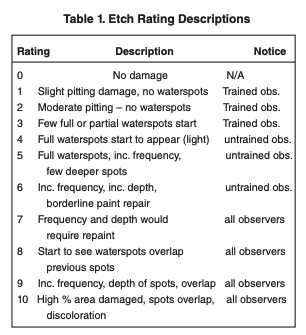
BASF Accelerated Acid Test Correlation Reults
Once all the critical parameters were combined into one test method, a series of exposure results were compared. After 200 hours in the Q-SUN tester, the relative rank order was well established and remained unchanged throughout the exposure period. These results were then compared to those obtained from the 2001 and 2002 Jacksonville outdoor data.
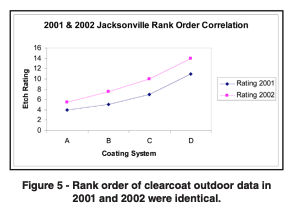
It was found that after 400 hours, the modified Q-SUN tester produced both the correct Spearman rank order (rho = 1.0) and approximately the same level of etching as seen after 14 weeks of the 2001 Jacksonville exposure (Figures 8 & 9). 700 hour BASF Accelerated Acid Test results were the essentially identical to 2002 Jacksonville data (figure 10). At the time it was deemed that 2001 was representative of the average Florida year, thus the BAAT duration was set for 420 hours of exposure. Of course, it was recognized that each season will see different results and the correlating test duration can be modified.
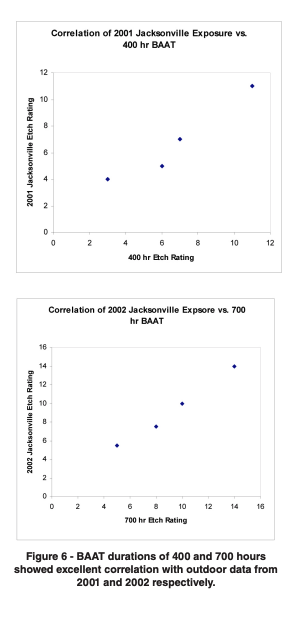
New Research
Now that the BASF Accelerated Acid Test has been developed and utilized for several years, new research and testing has been completed to improve correlation to outdoor applications and to better quantify etch ratings. Specifically, correlation between exposure sites, sample orientation, and sample type was examined on five clearcoat systems. Additionally, more exact techniques were developed to supplement visual ratings.
Enhanced Evaluation Techniques. Previously, only visual ratings were used to compare field results to accelerated acid etch results. In an effort to further quantify the etch damage, the morphology of the etched coating was studied using various instrumentation. Scanning Electron Microscope (SEM) technology was used to compare the etch damage of multiple coatings technologies.
A profilometer was then used to determine the depth of the etches. After analyzing the surfaces through both techniques, the BAAT test was shown to give very similar, yet more severe results, when compared to field exposure.
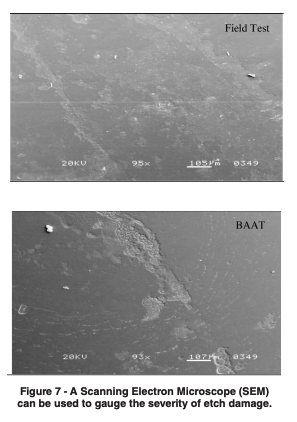
A third method, EDXS, was used to check for the similarity in degradation mechanisms between the field and BAAT tests. The results from this test indicated that the mechanisms were similar and that elevated silica levels were present in the technologies tested with BAAT (see circled peaks in Figure 8). This higher level indicates a more severe level of etching. These results support the conclusion made from the SEM and profilometer.
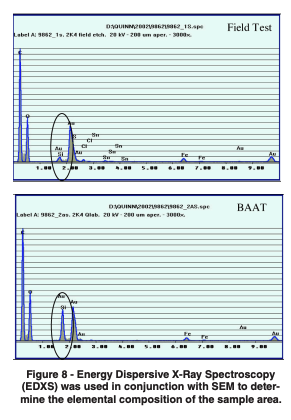
The results from these methodologies have confirmed the conclusions obtained through earlier work done with the BAAT. There is remarkably good correlation between the field and accelerated tests.
Expanded Outdoor Exposures
Comparison of Sites. There are several exposure sites on Blount Island. To determine if there was a significant difference between results from the sites, a comparison was done with 5 different clearcoats. Etch data from the 2004 season was collected from the exposure of various hoods at both sites. Upon analysis of the etch ratings, almost perfect correlation was found between the two sites.

Comparison of Orientation.
Another important consideration for outdoor testing is panel orientation. The effect of orientation on correlation has long been debated. It would logically follow that a 45 or 90 degree orientation would not have favorable correlation with outdoor etch exposure. In addition, field testing has confirmed that little or no etching takes place at these angles.
Panels and parts exposed outdoors in Jacksonville are positioned at the horizontal or near horizontal orientation angles (0o – 5o). To determine which orientation best produces the acid etch effect, extended outdoor testing on the same 5 clearcoat systems was done at both angles. Two factors were considered when evaluating the correlation between panel orientation: rank order and severity. While both orientations gave a very similar relative ranking, differences were seen in the rate at which etch occurred on the panels. The 0 degree panels displayed more severe etch than the 5 degree panel.
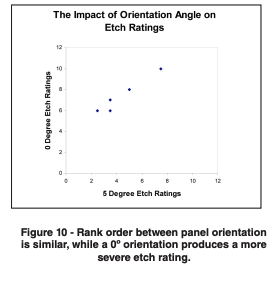
Correlation of Hood and Panel Testing. There are currently multiple methods for exposing specimens on Blount Island. One is through the use of steel panels and another in on actual car hoods. Comparison of etch ratings from the 0o panels to etch ratings on hoods at exposure site B displayed excellent correlation. This is encouraging since preparing and exposing panels is much less time consuming and expensive, yet it provides the same results.

Modified BASF Accelerated Acid Test
Since earlier reports, further work has been done to modify the cycle to enhance correlation and ease of use.
The Effect of Temperature. In round-robin testing between various laboratories, it was determined that it was difficult for some labs to maintain 38oC during a dark/spray cycle. This was because the labs operated at different ambient temperatures, thereby affecting the tester’s ability to achieve and maintain programmed conditions. To compensate for this constraint, considerable testing has been done at an elevated temperature of 50oC in the light step and 40oC during a dark/spray step. This testing continues to produce both the proper type of damage and the proper relationship among clearcoat technologies. Consequently, the modified cycle is currently being proposed as a new ASTM standard for the testing of acid etch.

Test Duration and Correlation. Annual variability in the forces of weathering cause differences in the etch results from year to year. In order to ensure that the BAAT test duration would correlate with a variety of seasonal outcomes, additional work was done to correlate the test duration with field exposure data from 2004 and 2005. Both a 400 hour and a 700 hour BAAT were performed on 5 clearcoat systems. The etch rating results were then compared to the results from exposure site B. While similar rankings were achieved between the two test durations, the 700 hour test displayed the best correlation with field exposure results for that particular year.
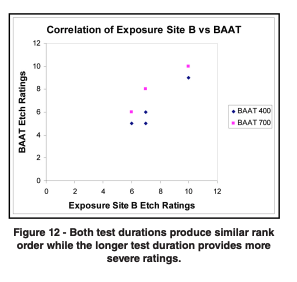
Current Status
Since the BASF Accelerated Acid Test was origi - nally developed in 2002, there have been a series of enhancements.
- The test has been available to the general public since July 2005.
- A preliminary test method has been written and submitted to ASTM for approval as a test method.
- The test is now consistently used by BASF to screen coatings prior to Jacksonville field expo - sure.
- Due to the excellent correlation to field exposure seen with BAAT, OEMs are now requesting data from the test.
- BAAT data is now being accepted by OEMs in place of data from other methods.
- Because BAAT is a viable replacement for Jack - sonville field test programs, BASF has continued to reduce the size and scope of their outdoor exposure testing.
- Modifications to the BAAT have improved the correlation and practicality of the technique
Summary & Conclusions
The BASF Accelerated Acid Test (BAAT) devel - oped jointly by BASF and Q-Lab Corporation provides many advantages for the testing of acid etch damage on automotive clear coat systems.
- The BAAT procedure allows for faster develop - ment of etch resistant coatings. Up to 20 itera - tions per year can be performed using this method vs. 1 iteration per year as dictated by natural Jacksonville exposures.
- The procedure has been modified to make it more practical for labs to perform.
- Instrumental analysis techniques have been shown to enhance understanding of etch damage.
- A 0 o orientation has been demonstrated to provide the fastest and most realistic etch results compared to real world data.
- Data shows that panels can be used as expo - sure substrates vs. actual car hoods to save time and expense.
- In the long run, the BAAT procedure should allow a reduction in the number of acid etch failures seen in service.
Acknowledgments
The authors would like to acknowledge the follow - ing contributors to the BASF Accelerated Acid Test development:
BASF Corporation P. Deskovitz L. Pattison T. Richards H. Valatka M. Garner D. Barber
Q-Lab Corporation D. Fayak G. Fedor J. Quill
References
- ASTM G151, Standard Practice for Exposing Nonmetallic Materials in Accelerated Test Devices that Use Laboratory Light Sources.
- ASTM G155, Standard Practice for Operating Xenon Arc Light Apparatus for Exposure of Nonmetallic Materials.
- Brennan, P. J, Static and Rotating Xenon Arc Exposures Compared: technical issues, practical considerations, & how different types of hardware comply to the new performance- based test methods. 1st European Weathering Symposium. Prague, Czech Republic.
- Boisseau, J., et al. Accelerated Acid Etch for Automotive Clearcoats: A Joint Research Project Provides Lab & Field Correlation Paint & Coatings Industry Magazine, June 2005.
- CIE 85, Table 4. Publication Number 85: 1989, Technical Report - Solar Spectral Irradiance.
- Grossman, P. R., Investigation of Atmospheric Exposure Factors that Determine Time-of- Wetness of Outdoor Structures, in Atmospheric Factors Affecting the Corrosion of Engineering Materials, ASTM STP 646, Coburn, S. K., Ed., American Society of Testing and Materials, 1978.
- ISO 4892-2, Plastics - Methods of exposure to laboratory light sources - Part 2: Xenonarc sources.
- ISO 11341, Paints and varnishes - Artificial weathering and exposure to artificial radiation - Exposure to filtered xenon-arc radiation.
- SAE J1960, Accelerated Exposure of Automotive Exterior Material Using a Controlled Irradiance Water Cooled Xenon- Arc Apparatus.
- SAE J2527, Accelerated Exposure of Automotive Exterior Materials Using a Controlled Irradiance Xenon Arc Apparatus.
Notes
A US Patent has been filed jointly by BASF Corporation and Q-Lab Corporation that covers this test method and apparatus.